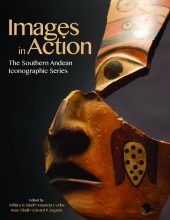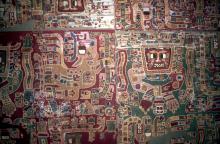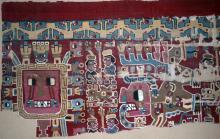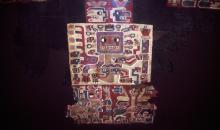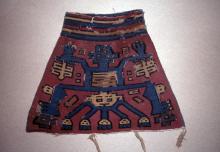Visual database
Early Nasca bottle featuring an "oculate rayed head" image, with ringed eyes and mouth, eight straight (star-like) rays, and eight hooked rays. MRI 2926.
Lower panel of a tunic excavated in a group of offering and burial pits set into an anthropogenic mound at the site of San Miguel de Azapa. The slit tapestry panel was woven on paired white warps that had been scaffolded onto the loomstring end of a previously woven warp-striped tunic. MASMA.
Band constructed in interlinked tapestry on paired warps, excavated in a sector of burials placed in large baskets at the Azapa Valley Museo site (Azapa 115) MASMA.
Postincursion SAIS, Konchopata style, detail of a tunic in interlocking tapestry with representations of the "Captive Staff God" theme, dated cal. AD 694 to 884 (SH 777-961). Weft in camelid fibers and cotton warp. Private collection.
Postincursion SAIS, Konchopata style, detail of a textile fragment in interlocking tapestry with representations of the "Fire Textile" theme, dated cal. AD 712 to 888 (SH 779-968). Weft in camelid fibers and cotton warp. Private collection.
Postincursion SAIS, Konchopata style, detail of a partially preserved tunic in interlocking tapestry with a representation of a "Running Winged Staff God" and remains of "Fire Textile" iconography. Not shown are the two Rayed Heads and four Winged Attendants similar to those of Figure 6.2 but arranged symmetrically along a band with severed heads from which sprout Anadenanthera colubrinasymbols. Weft in camelid fibers and cotton warp. Private collection.
Incursion SAIS, detail of a striped tunic in interlocking tapestry with a Stepped Volute and Head design, dated cal. AD 676 to 861 (SH 719-895). Weft camelid fibers and warp (horizontal as worn) in cotton. Private collection.
Postincursion SAIS, bag in interlocking tapestry dated cal. AD 694 to 888 (SH 778-970). Weft and binding in crosslooping in camelid fibers and cotton warp in two shades. Represented on the illustrated side is the head of Agent 103 and on the other side that of Agent 100 (for description of Wari agents, see http://whowaswhowari.sdsu.edu/WWWAgents.html#100, by Patricia Knobloch). Private collection.
Chakipampa, humped animal represented on one side of a bag in slit tapestry, dated cal. AD 659 to 766 (SH 677-780). Weft is in camelid fibers and vertical double warp yarns in cotton, one white and the other light brown. Fringe is in cotton. Private collection.
Chakipampa, opposite side of the bag shown in Figure 6.6.
